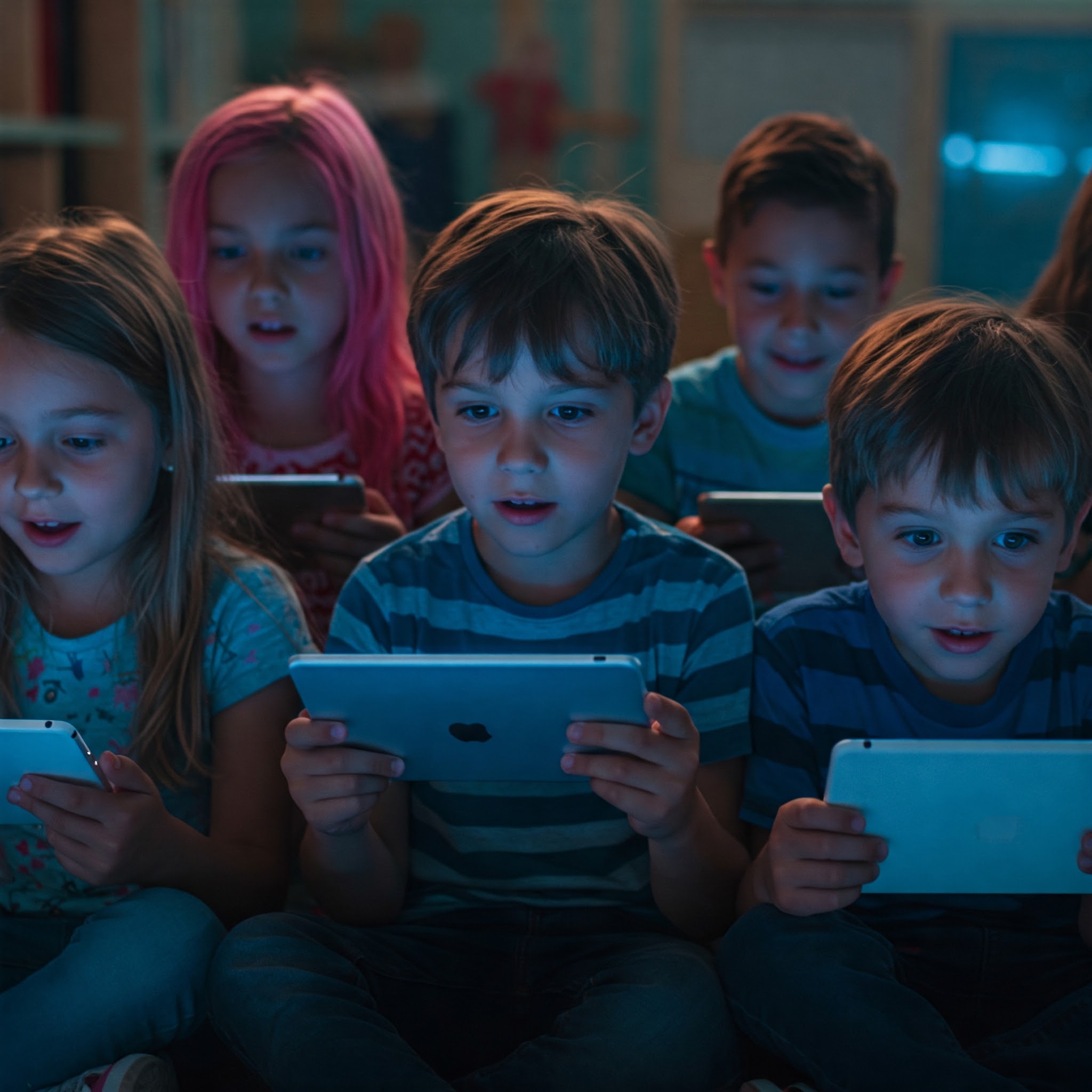
There’s a certain hollowness in the stare. A glaze, like morning dew that never quite clears. It’s in the way a child zones out, lips slightly parted, eyes reflecting the artificial glow of the screen rather than the spark of curiosity. You call their name. Once. Twice. A third time. Nothing.
Welcome to the age of the “Glazed-Eye Epidemic: Understanding the Impact of Excessive Screen Time on Kids.”
In this shimmering, fast-scrolling, always-connected world, childhood is being redefined pixel by pixel. Tablets at dinner. Phones before bed. Screens to pacify, distract, educate, entertain, and—more and more—replace. What started as a modern marvel of convenience has quietly grown into a digital dependence so invasive it warps attention spans, dulls emotions, and dims imaginations.
But before we spiral into doom, take heart—this isn’t a eulogy. It’s a resurrection.
Recognizing the Signs: Is Your Child More Screen-Engaged Than Life-Engaged
Children don’t become screen zombies overnight. It starts with quiet acquiescence. The iPad during errands. A phone game to ease a tantrum. You begin to notice:
- The vacant stare mid-conversation.
- The sudden aggression when a device is taken away.
- The erosion of interest in books, blocks, or backyard adventures.
- Mood swings that echo addiction withdrawal.
Sound familiar? These are not quirks of growing up in 2025. They’re warning flares—symptoms of being more screen-engaged than life-engaged.
When a child loses themselves in the vortex of screen-based stimulation, the real world dims. Social cues become foreign. Play loses its luster. The color drains from human connection.
And as parents, we ask ourselves: Is this just the new normal—or is there a way back?
Laying the Groundwork: Preparing for a Successful Digital Detox (Without Mutiny!)
Imagine this: You announce a weeklong screen detox. Your child looks at you as if you’ve just outlawed oxygen.
Detox doesn’t mean destruction. It requires strategy, empathy, and—most of all—preparation.
Here’s the emotional scaffolding needed for a rebellion-free reset:
1. A Family Mission, Not a Punishment
Frame the detox as a collective adventure. Let your child be part of the planning. Set a name for the week: “Reboot Week” or “Unplugged Adventures.” Give it narrative. Give it power.
2. Create a Countdown
Avoid dropping the news like a hammer. Build anticipation. Use visual countdowns—chalkboards, stickers, paper chains. Let the detox feel like the lead-up to an epic quest.
3. Replace, Don’t Just Remove
Know this: nature abhors a vacuum. So do children. If you remove screens without inserting alternatives, chaos will erupt. Start brainstorming replacements early—board games, art stations, DIY scavenger hunts, pillow forts worthy of legend.
4. Set the Scene
Transform your environment. Hide or lock away devices. Reorganize living spaces to center around activity, not entertainment. Make the home feel alive, not unplugged.
Because a successful digital detox isn’t about deprivation. It’s about rediscovery.
The Cold Turkey (or Gradual Cutback?): Choosing the Right Detox Approach for Your Family
Now comes the fork in the road: Do you rip off the Band-Aid or peel it gently?
The Cold Turkey Approach
Swift. Intense. Immediate. No screens, no exceptions. Works best for:
- Younger children (ages 2–6) with less ingrained habits.
- Families ready to dive in together.
- Crisis-level screen habits needing a hard reset.
It’s like digital rehab—jarring at first, but sometimes essential.
The Gradual Cutback Approach
Incremental change. Timed reduction. Replacement-based transitions. Ideal for:
- Older kids and tweens with established routines.
- Screen use tied to schoolwork or socializing.
- Households managing multiple age ranges.
Start with one screen-free day per week. Then, cut screen time by 15 minutes daily. Use tools like timers, apps, or visual clocks. Celebrate every milestone.
Whichever route you take, the key is consistency cloaked in compassion. Don’t flip-flop. Don’t give in. Hold the line gently, but firmly. Like a shepherd guiding wayward sheep back to the meadow.
Beyond the Screen: Filling the Void with Engaging Activities and Real-World Connections
Once the hypnotic spell of screens begins to fade, something magical—and slightly chaotic—happens: boredom.
Don’t fear it. Boredom is the fertile soil from which imagination blooms. But it needs nutrients.
Here’s how to fill the screen-shaped void with soul-nourishing experiences:
1. The Wild Outdoors
Rediscover the majestic chaos of nature. Parks, trails, puddles. Teach them to climb trees. Lie on grass. Count stars. Get dirty. Get tired. Get real.
2. Analog Joy
Board games. Puzzles. Tangible fun. Let them feel the click of dice, the thrill of a card flip. Bonus: face-to-face interaction sharpens empathy and social skills.
3. Tactile Creation
Crafts. Legos. Baking. Knitting. Painting. Give them tools that require hands, not thumbs.
4. The Spark of Storytelling
Read aloud. Roleplay. Build characters and kingdoms. Let language and lore fill the void left by passive watching.
5. Community Connection
Encourage playdates, co-op learning groups, volunteer projects. Show them that connection exists beyond Wi-Fi.
Because it’s not just about removing screens. It’s about reminding your child that the real world is infinite.
Navigating the Resistance and Relapses: Strategies for Staying the Course and Maintaining Balance
Let’s be honest: it won’t all be smooth sailing. Expect pushback. Tears. Bargaining. Even full-on mutinies.
But know this—it’s not failure. It’s withdrawal.
How to Stand Strong Through Stormy Waters
- Don’t personalize the protest. This isn’t about your parenting. It’s about their wiring.
- Acknowledge the loss. Empathize: “I know you miss your game. That’s totally okay to feel.”
- Redirect with excitement. Always have a Plan B on hand: “No screen now, but let’s bake a monster cake instead!”
- Use visual progress tools. Charts, tokens, or “unplugged points” they can earn toward a screen-free reward.
- Set crystal-clear boundaries. Consistency is the balm for chaos. Keep expectations non-negotiable.
And when they relapse? When they sneak a tablet? When Grandma caves and hands them a phone?
Breathe.
Reset. Repair. Reaffirm.
Balance isn’t perfection—it’s persistence.
Life Reclaimed: Celebrating the Benefits of a Balanced Digital Diet and a Thriving Child
Weeks go by. Something shifts. Their laughter becomes richer. They start conversations. Their sleep deepens. They play longer. Their gaze regains depth.
Congratulations. You’re witnessing a life reclaimed.
Here’s what begins to unfold with a balanced digital diet:
- Imagination reborn. Watch them create entire civilizations from cardboard.
- Social intelligence sharpened. Eye contact returns. Empathy grows. Conversations deepen.
- Emotional regulation improves. Tantrums decrease. Patience builds.
- Physical wellness blooms. Better posture. More movement. Healthier routines.
- Academic focus realigns. Without constant stimulation, their minds reset. Curiosity takes root again.
And you? You feel the reconnection. The weight lifted. The joy of parenting a present, vibrant child.
This isn’t about demonizing technology. It’s about wielding it wisely. Like fire, it can cook your food or burn your home. Balance is the matchstick.
The Epilogue: Raising Children Who Use Tech, Not Worship It
The truth? Your child will live in a world of screens. They’ll text. They’ll scroll. They’ll code. That’s okay.
The goal isn’t to raise screen-averse Luddites.
It’s to raise tech-resilient, soul-rich humans who know when to plug in—and when to step away.
To cultivate a generation that uses technology as a tool, not a tether.
To remind our children—and ourselves—that the most important connection isn’t Bluetooth.
It’s human.




